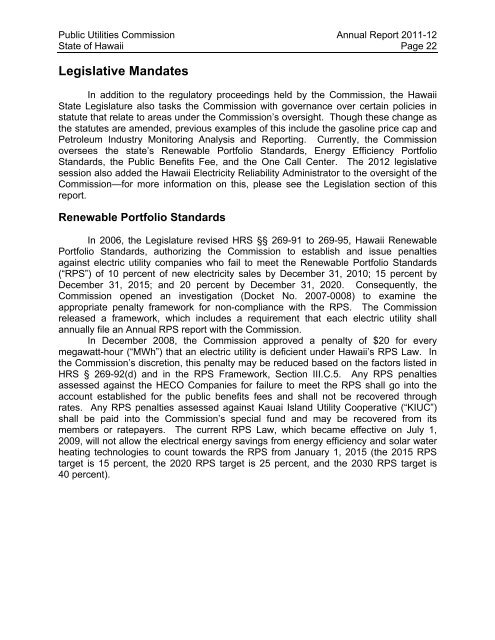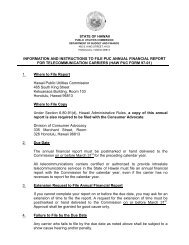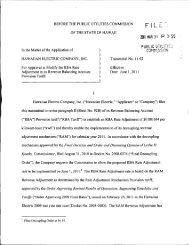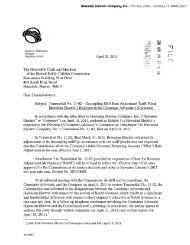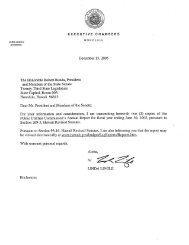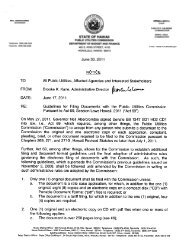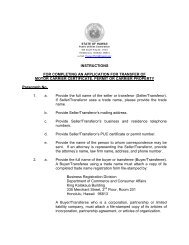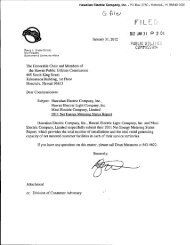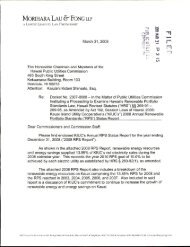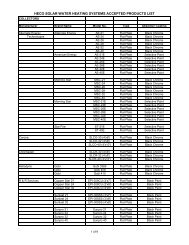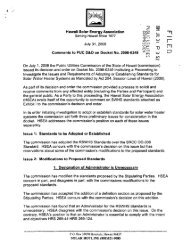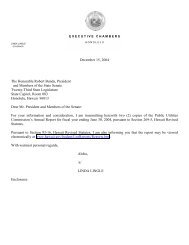PUC Annual ReportâFiscal Year 2011-12 - Public Utilities Commission
PUC Annual ReportâFiscal Year 2011-12 - Public Utilities Commission
PUC Annual ReportâFiscal Year 2011-12 - Public Utilities Commission
Create successful ePaper yourself
Turn your PDF publications into a flip-book with our unique Google optimized e-Paper software.
<strong>Public</strong> <strong>Utilities</strong> <strong>Commission</strong> <strong>Annual</strong> Report <strong>2011</strong>-<strong>12</strong><br />
State of Hawaii Page 22<br />
Legislative Mandates<br />
In addition to the regulatory proceedings held by the <strong>Commission</strong>, the Hawaii<br />
State Legislature also tasks the <strong>Commission</strong> with governance over certain policies in<br />
statute that relate to areas under the <strong>Commission</strong>’s oversight. Though these change as<br />
the statutes are amended, previous examples of this include the gasoline price cap and<br />
Petroleum Industry Monitoring Analysis and Reporting. Currently, the <strong>Commission</strong><br />
oversees the state’s Renewable Portfolio Standards, Energy Efficiency Portfolio<br />
Standards, the <strong>Public</strong> Benefits Fee, and the One Call Center. The 20<strong>12</strong> legislative<br />
session also added the Hawaii Electricity Reliability Administrator to the oversight of the<br />
<strong>Commission</strong>—for more information on this, please see the Legislation section of this<br />
report.<br />
Renewable Portfolio Standards<br />
In 2006, the Legislature revised HRS §§ 269-91 to 269-95, Hawaii Renewable<br />
Portfolio Standards, authorizing the <strong>Commission</strong> to establish and issue penalties<br />
against electric utility companies who fail to meet the Renewable Portfolio Standards<br />
(“RPS”) of 10 percent of new electricity sales by December 31, 2010; 15 percent by<br />
December 31, 2015; and 20 percent by December 31, 2020. Consequently, the<br />
<strong>Commission</strong> opened an investigation (Docket No. 2007-0008) to examine the<br />
appropriate penalty framework for non-compliance with the RPS. The <strong>Commission</strong><br />
released a framework, which includes a requirement that each electric utility shall<br />
annually file an <strong>Annual</strong> RPS report with the <strong>Commission</strong>.<br />
In December 2008, the <strong>Commission</strong> approved a penalty of $20 for every<br />
megawatt-hour (“MWh”) that an electric utility is deficient under Hawaii’s RPS Law. In<br />
the <strong>Commission</strong>’s discretion, this penalty may be reduced based on the factors listed in<br />
HRS § 269-92(d) and in the RPS Framework, Section III.C.5. Any RPS penalties<br />
assessed against the HECO Companies for failure to meet the RPS shall go into the<br />
account established for the public benefits fees and shall not be recovered through<br />
rates. Any RPS penalties assessed against Kauai Island Utility Cooperative (“KIUC”)<br />
shall be paid into the <strong>Commission</strong>’s special fund and may be recovered from its<br />
members or ratepayers. The current RPS Law, which became effective on July 1,<br />
2009, will not allow the electrical energy savings from energy efficiency and solar water<br />
heating technologies to count towards the RPS from January 1, 2015 (the 2015 RPS<br />
target is 15 percent, the 2020 RPS target is 25 percent, and the 2030 RPS target is<br />
40 percent).


